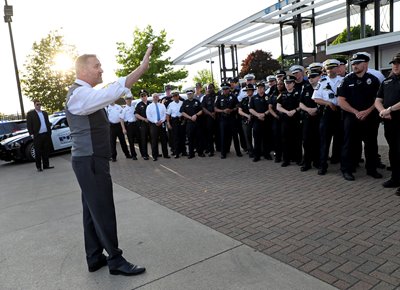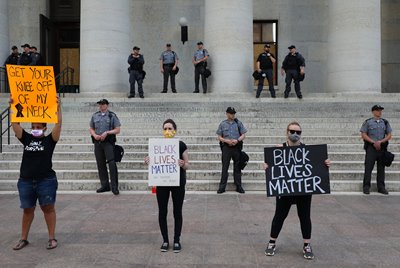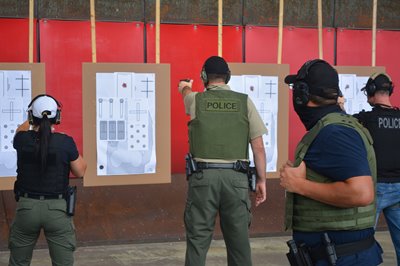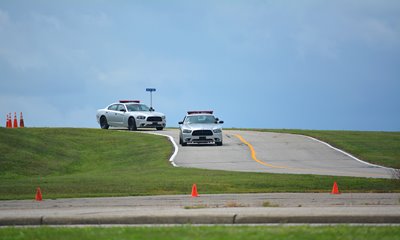
When a cop puts on the badge, it is an act of courage — an act that accepts the risks of the job, that promises to place the good of the community above his or her own welfare.
To support the defunding of local law enforcement, people must choose to ignore that basic fact and believe several things that are simply not true: that officers regularly shoot unarmed people, wantonly discriminate and gas protesters — and that they delight in doing so.
“I’ve known many more officers and deputies who have arrested child abusers, murderers and traffickers than cops who have ever had to fire their weapon in the line of duty,” said Attorney General Dave Yost, who readily acknowledges that “defund” campaigns tick him off.
“I’ve known more officers and deputies who have run into burning buildings to save perfect strangers or who have bought groceries for single moms with hungry kids.
“The vast majority of law enforcement officers are goodhearted, disciplined professionals who took a dangerous job because they want to make their communities safe, not because they want to crack down on innocents and go to war in their own towns,” Yost said.
To be sure, there is a disparity in the way people see law enforcement. Only 15% supported the Minneapolis plan to disband its police department in a Gallup poll this summer, and an ABC News/Ipsos poll found that Americans oppose the “defund” movement by a 2-1 ratio (64%-34%). On the other hand, a Quinnipiac poll conducted during the summer showed that 60% of black Ohioans fear becoming a victim of police violence, compared with 9% of whites.
These findings help explain why many minority children are taught growing up to always get a receipt or a bag with their purchases at a store, to avoid wearing a hoodie or to ask permission to reach for their driver’s license during a traffic stop.
Most white kids don’t grow up with such warnings.
“Intended or not, racism exists,” Yost said. “But it’s important to recognize that we don’t have a police problem; we have a
societal problem that has a law enforcement component.”
Accountability
This summer, Attorney General Yost teamed with Gov. Mike DeWine to develop proposals intended to build public trust in law enforcement, including asking the Ohio General Assembly to identify permanent funding for advanced training of law enforcement officers.
Ohio hasn’t allocated money for police training since 2017, so the decision on whether officers get training depends on local budgets, which often are tight. Calls for de-escalation training and the like ring hollow when there is no money to pay for it.
Yost sees this reality as unfair. He believes that officers putting their lives on the line to keep communities safe deserve regular training on best practices, regardless of the Ohio community they serve.
Still, he said, an even more essential step should be taken to strengthen the law enforcement ranks.
“At the end of the day, what we really need to do is get rid of the few bad cops who are acting out and giving law enforcement a bad name.”
To do so, Yost and DeWine propose creating a state licensing board, similar to those Ohio has for barbers, construction-industry contractors, lawyers, medical workers of all kinds, social workers and teachers.
The plan would essentially add an oversight and accountability board to the Ohio Peace Officer Training Commission and Academy. The board, which would include active law enforcement officers, would work with law enforcement veterans and experts to set professional standards and a code of ethics.
Priorities would be fairness, due-process safeguards and transparency — not penalizing officers for having imperfect knowledge at the time of an incident. Violations could result in a license being suspended or revoked, which would disqualify those unfit for the job from policing in Ohio, instead of allowing them to move to another unsuspecting department when they run into trouble.
Yost wants officers and deputies to know: “Bad cops are making your job and your mission harder. Those few bad cops are making you less safe on the street. They’re why you’re being painted with the same broad brush.”

In fact, protests this summer came at a time when police agencies are the most professional in history. More training than ever is required to become a certified officer, including more than 100 hours that deal with different types of de-escalation. Also, many law enforcement agencies in the state have been working hard to improve community policing — in some areas, after officer-involved shootings and/or U.S. Justice Department involvement in the past decade or so.
“We know we can do better because we already are doing better,” Yost said. “And there’s no limit to how good we can become.”
Training
Three days before George Floyd died in Minneapolis, the attorney general moved to enact major reforms at OPOTA.
The COVID-19 pandemic had accelerated the timing: The training facility had come to rely on casino proceeds, and empty casinos meant a payment 13 times smaller than usual.
But Yost had started looking at OPOTA’s costs and benefits even before the pandemic.
“When I was running for office, one of the things I heard was, ‘Hey, we legalized casinos, and we were supposed to get 2% of the money for training and where is it? Because we’re not seeing it,’” he said. “Well, we found out that money was going to fund state institutions.”
Yost also learned that many police agencies preferred training offered closer to home by private companies, community colleges or larger police departments. Such classes meant an officer didn’t have to travel all the way to London, Ohio, and the department didn’t have to cover as many shifts.
In fact, attendance in some OPOTA classes had fallen to five people.
Large-scale changes made sense.
“What some people think is that when all of the changes happened, OPOTA permanently closed,” said Dwight Holcomb, OPOTA’s executive director. “That’s not the case at all.”
 Officers train on OPOTA's shooting range.
Officers train on OPOTA's shooting range.
As physical classes reopen (after the break forced by COVID-19), Holcomb said, OPOTA will initially focus on a handful of areas:
- Classes for teachers: Instructor-level courses will certify people, such as police departments’ training officers, to teach advanced training classes or at basic academies (which haven’t been directly taught by OPOTA for years).
- Anything required by Ohio law: Such as the 40-hour course for new police chiefs.
- Driving, traffic stops and related courses: OPOTA has the state’s only large-scale driving track for law enforcement, and the popular courses draw officers from across the state and nation.
- Firearms: Two full-time instructors remain on staff and will teach such classes in London, but OPOTA also will partner with regional ranges and experts to spread classes throughout the state.
OPOTA next will determine which advanced training classes to provide. To help, the attorney general reached out to sheriffs and police chiefs, and the academy emailed more than 30,000 officers in July to ask for opinions.
Leaders will tap policing data to see where training can benefit officers. They expect scenario-based training to factor into all of the answers, as such methods effectively help break down biases and build decision-making skills on use of force and de-escalation.
“Basically, we are identifying the classes that will be most valuable to front-line officers, and then we’ll go out and find the best people to teach them,” Yost said.
OPOTA’s two training coordinators are tasked with finding those high-quality partners, a priority both to make the training cost effective and so that experts in their fields can share the newest methodologies and most up-to-date real-world experience. For example, for the new police chiefs course, OPOTA is working with the Ohio Association of Chiefs of Police to bring in talented current chiefs to lead the classes.
Making courses and testing more convenient and accessible is another of OPOTA’s main priorities moving forward. That entails both developing classes physically closer to law enforcement agencies and revamping eOPOTA so that subjects that can be taught online are well-presented. OPOTA plans to have new coursework available by the end of the year.
“As always, our goal is to do a better job,” Yost said. “What we’re doing is making OPOTA more responsive, more local and more efficient, and that will help officers better serve their communities.”
 Police cars navigate OPOTA's driving track.
Police cars navigate OPOTA's driving track.
For training & accountability
These plans were pitched by Attorney General Dave Yost and Gov. Mike DeWine in June. Most would need to be passed by the General Assembly.
Oversight board
Purpose: To build accountability and prevent bad cops from simply moving to another agency
» Would establish professional standards and a code of conduct for law enforcement
» Would ensure that law enforcement officers adhere to code or risk license
Independent use-of-force investigations
Purpose: To build public trust in the results of investigations of officers
» Would require that a neutral third party, such as the Ohio Bureau of Criminal Investigation (BCI), investigate officer-involved critical incidents
» Would mandate that outside prosecutors also be assigned to shootings and in-custody deaths
BCI officer-involved shooting investigative unit
Purpose: To aid in independent investigations of officer-involved critical incidents
» Specialized response team at BCI established by the AG
» Would investigate as requested
» Has agreed to take on all critical incidents by State Highway Patrol and Columbus PD
Chokehold ban
Purpose: To allow use of potentially dangerous tactic only when an officer’s life is in danger
Advanced training
Purpose: To create a regular funding stream to pay for advanced training for LEOs
Basic-training psychological checks
Purpose: To help ensure that only those with appropriate temperament become officers
» Would require basic training applicants to pass a psychological exam
» Would require the Ohio Police Officer Training Commission, after a cadet graduates, to check references, etc. to ensure candidate possesses appropriate character before issuing a certification
Body cameras
Purpose: To make police body cameras more widespread
» Would provide funding for equipment and video storage
» By governor’s order, OSHP troopers will be outfitted with the cameras.